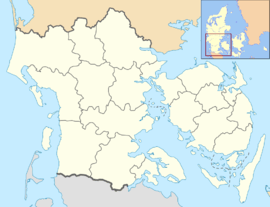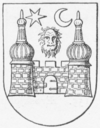Nyborg
| Nyborg | ||
|---|---|---|
|
Nyborg Palace | ||
| ||
 Nyborg Location in the Region of Southern Denmark | ||
| Coordinates: 55°18′N 10°47′E / 55.300°N 10.783°ECoordinates: 55°18′N 10°47′E / 55.300°N 10.783°E | ||
| Country | Denmark | |
| Region | Southern Denmark (Syddanmark) | |
| Municipality | Nyborg | |
| Population (2014)[1] | ||
| • Total | 16,528 | |
| Website |
http://www.nyborg.dk http://www.fyn.dk | |
Nyborg is a city in central Denmark, located in Nyborg Municipality on the island of Funen and with a population of 16,528 (as of 1 January 2014). Nyborg is one of the 14 large municipalities created on 1 January 2007. This change boosted the population of Nyborg Municipality from around 18,000 to 31,009.

History

Nyborg was first mentioned in 1193 in the history of Denmark as Nyborg Castle, which still exists today, but the town itself was not mentioned before the year 1202. In the 17th century, Nyborg was one of three major, fortified towns in Denmark, together with Fredericia and Copenhagen. Each was placed near an important body of water - in Nyborg's case, the Great Belt (Storebælt). In 1659 the city was captured by the Swedes and relieved by an expeditionary fleet sent by the Dutch, then Denmark's allies, commanded by admiral De Ruyter.
In 1867 the fortress was abolished and the town expanded beyond the ramparts. Much of the town's southern ramparts were destroyed in this process and converted into residential areas. The western and much of the northern ramparts still exist and form the scene of an annual theatre known as Nyborg Voldspil, which is Denmark's oldest outdoor theater.
From 1183 to 1413 it was the gathering place for Danehoffet, which was the country's legislative and judicial assembly. Nyborg is therefore considered Denmark's capital during this period. Christian II of Denmark was born at Nyborg Castle.
In 2005, plans about expanding Nyborg Harbour came to life and Nyborg Harbour, which previously connected Funen to Sealand with the old ferries (until 1996) now contains several large luxury-apartment buildings.
Nyborg Church
Nyborg church - or Church of Our Lady, which is the real name - was built between 1388–1428 and was dedicated to Jesus' mother, Mary, on the opening during Pentecost 1428.
The church has two organs: the large main organ, built in 1973 by organ builder Poul-Gerhard Andersen and the choir organ from 1830, also called Demant organ after the builder, PUF Demant.
The crucifix is the only piece of inventory in the church, which is preserved from the original layout at the inauguration in 1428. The Gothic crucifix is decorated with small leaves, symbolizing the crucifix as a tree of life.
Twin towns
References
- ↑ BEF44: Population 1st January, by urban areas database from Statistics Denmark
External links
| ||||||||||||||||||||||
| ||||||||||||||||||||||

